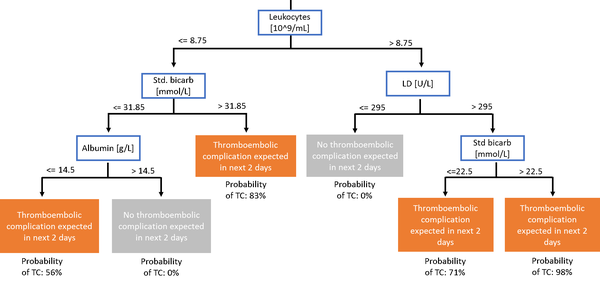-
Home
-
About JCTR
-
Gold Open Access
-
Issues
-
Editorial board
-
Author guidelines
-
Publication fees
-
Online first
-
Special issues
-
News
-
Publication ethics
-
Partners
-
Submit your manuscript
-
Submit your review report
-
Editorial Office
-

This work is licensed under a Creative Commons Attribution-NonCommercial 4.0 International License. ISSN print: 2382-6533 ISSN online: 2424-810X
Volume 6 Issue 5
Predicting thromboembolic complications in COVID-19 ICU patients using machine learning
Davy van de Sande, Michel E. van Genderen, Babette Rosman, Maren Diether, Henrik Endeman, Johannes P.C. van den Akker, Martijn Ludwig, Joost Huiskens, Diederik Gommers, Jasper van Bommel
van de Sande et al. J Clin Transl Res 2020; 6(5):3
Published online: October 14, 2020
Abstract
BACKGROUND:
The coronavirus disease 2019 (COVID-19) pandemic is a challenge for intensive care units (ICU) in part due to the failure to identify risks for patients early and the inability to render an accurate prognosis. Previous reports suggest a strong association between hypercoagulability and poor outcome. Factors related to hemostasis may therefore serve as tools to improve the management of COVID-19 patients.
AIM: The purpose of this report is to develop a model to determine whether it is possible to early identify COVID-19 patients at risk for thromboembolic complications.
METHODS:We analyzed electronic health record data of 108 consecutive COVID-19 patients admitted to the adult ICU of the Erasmus University Medical Center between February 27 and May 20, 2020. By training a decision tree classifier on 66% of the available data, a model for the prediction of thromboembolic complications was developed.
RESULTS: The median (inter quartile range) age was 62 [53-70] years and 73% were male. Forty-three patients (40%) developed a thromboembolic complication during their ICU stay. Mortality was higher for patients in the thromboembolic complications group compared to the control group (26% vs 8%, p = 0.03). Lactate dehydrogenase, standardized bicarbonate, albumin, and leukocytes were identified by the Decision Tree classifier as most powerful predictors for thromboembolic complications two days prior to the onset of the thromboembolic complication, with a positive predictive value of 67% and a positive likelihood ratio of 2.7.
CONCLUSIONS: Clinically relevant thromboembolic complications frequently occur in critically ill COVID-19 patients. These can successfully be predicted using a decision tree model. Although this model could be of special importance to aid clinical decision making, its generalizability and clinical impact should be determined in a larger population.
Relevance for patients: Recently, severe thromboembolic complications were observed in COVID-19 patients with progressive respiratory failure warranting ICU treatment. Timely identification of patients at risk of developing thromboembolic complications (TC) is critical inasmuch as it would enable clinicians to initiate potentially salvaging therapeutic anticoagulation.

DOI: http://dx.doi.org/10.18053/jctres.06.202005.003
Author affiliation
1. Department of Adult Intensive Care, Erasmus University Medical Center, Rotterdam, the Netherlands
2. Deloitte Netherlands, Analytics & Cognitive, Amsterdam, the Netherlands
3. SAS Institute, Health Care Analytics, Huizen, the Netherlands
*Corresponding author
Michel E. van Genderen
Erasmus Medical Center , Department of Adult Intensive Care, Room Ne-411, Doctor Molewaterplein 40, 3015 GD Rotterdam, the Netherlands
Email: m.vangenderen@erasmusmc.nl
Handling editor:
Michal Heger
Department of Pharmaceutics, Utrecht University, the Netherlands
Department of Pharmaceutics, Jiaxing University Medical College, Zhejiang, China

